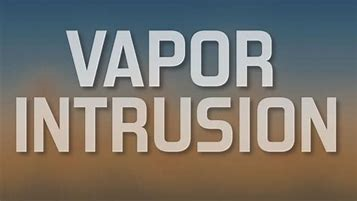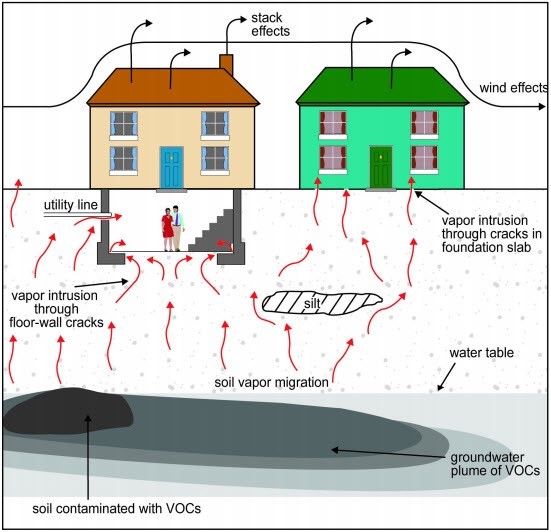Emerging Contaminants
This emerging Contaminants Spotlight covers the topic of vapor intrusion. Although not an

“emerging contaminant” per se, vapor intrusion, or VI, is a continuously evolving field as evidenced by changing standards for contaminants of concern, advances in sampling and analytical technologies, and better understanding of the variability of VI and its effects on indoor air concentrations with time.
Examples of each are discussed below.

What is Vapor Intrusion?
Volatile contaminants in groundwater or soil form vapors that migrate upward through the soil column and enter an overlying structure through the foundation via joints, cracks, utility penetrations, etc. Once inside, the vapor can potentially reach concentration levels that become an inhalation hazard for human occupants. Common VI contaminants of concern include chlorinated solvents (e.g., tetrachloroethene [PCE] and trichloroethene [TCE]) and petroleum hydrocarbons (e.g.,benzene). While many VI issues are the result of environmental contamination, radon gas is an example of a naturally occurring VI hazard.
Changing Standards
In 2011, the USEPA released a toxicity profile for TCE that lowered the short-term inhalation reference concentration to 2 micrograms per cubic meter (µg/m3). This change caused many states to re-evaluate contaminated sites for TCE VI risk. Some states have adopted 2 µg/m3 as an indoor air remediation target for TCE and have developed imminent hazard levels only slightly higher. For example, the Massachusetts Department of Environmental Protection (MA DEP) established a residential imminent hazard TCE concentration of 6 µg/m3, above which immediate response actions must be taken to notify sensitive populations, notify MA DEP, and initiate response actions to eliminate the imminent hazard. Regulatory thresholds vary from state to state, and it is important to understand the regulatory thresholds in the states where you’re working.
Data Collection Challenges
Collecting representative indoor air quality data to accurately model or predict risk to human health can be challenging. A complicating factor in conducting VI assessments is the sometimes competing need to collect indoor air samples that are representative of both: 1) worst case VI conditions, and 2) potential long-term exposure.
Indoor air concentrations change on a continuous basis due to many variables, including environmental condition (e.g. temperature, barometric pressure, wind, and precipitation), and building conditions (e.g., heating and cooling system operations, door and window positions). Another complicating factor of VI assessments is understanding whether indoor air contamination is a result background sources such as stored chemicals in the building, or even building materials. Thus, it is difficult to collect a single sample and draw conclusions about VI risk.
to many variables, including environmental condition (e.g. temperature, barometric pressure, wind, and precipitation), and building conditions (e.g., heating and cooling system operations, door and window positions). Another complicating factor of VI assessments is understanding whether indoor air contamination is a result background sources such as stored chemicals in the building, or even building materials. Thus, it is difficult to collect a single sample and draw conclusions about VI risk.
The USEPA is conducting research to better understand what parameters might best serve to guide indoor air sampling programs for VI assessment. Field screening equipment, such as portable gas chromatographs, can help with collecting peak and average values over time, as wells as evaluating  potential background vapor concerns in discrete areas of the building without the added costs of a mobile laboratory.
potential background vapor concerns in discrete areas of the building without the added costs of a mobile laboratory.
Where are the Opportunities to provide Consulting Services?
Environmental business opportunities related to VI continue to grow as regulatory attention grows. The assessment of vapor intrusion can be complex and variable. Regulations frequently change, and current standards and guidelines should be reviewed in the states where work is being conducted. Collecting a representative indoor air sample to assess VI can be a challenge given the variability of VI under different conditions. Advances in field instrumentation offer the opportunity to gain an improved understanding of the variability and potential sources of contamination in indoor air on a building-specific basis.
This article generously provided by GBA’s Environmental Business Council to benefit all geoprofessionals providing environmental consulting services. It was prepared by: Jennifer Sanborn, P.E.; Sanborn, Head & Associates, Inc.
(all images courtesy of Internet)
Additional Resources
USEPA Vapor Intrusion Webpage: https://www.epa.gov/vaporintrusion
Massachusetts Department of Environmental Protection, “US EPA Trichloroethylene Toxicity Values and Office of Research and Standards Recommendations Regarding Remediation Targets and Timeframes to Address Potential Developmental Risks”, August 15, 2014. https://www.mass.gov/files/documents/2016/08/pw/tcevalsm.pdf